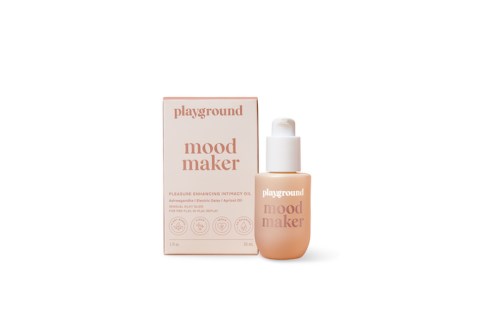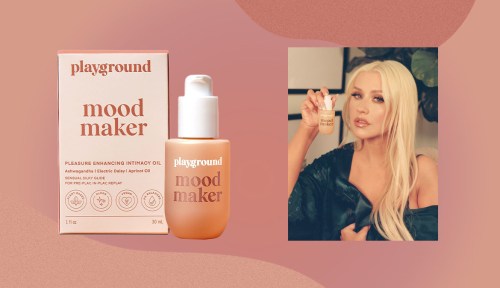Our editors independently select these products. Making a purchase through our links may earn Well+Good a commission
Pop star Christina Aguilera has long encouraged women to embrace and celebrate their sexuality by way of her song lyrics. But earlier this year, she put her money where her music is and became the co-founder and chief brand officer at sexual-wellness brand Playground—which, as its name implies, is all about bringing out the fun and joy of sex. The brand’s first launches were four personal lubricants with soothing skincare-like ingredients and haute fragrances. And now, it’s expanding to a new category with the launch of an intimacy oil called Mood Maker, designed to help you, well, cum… (on over), baby.
Experts in This Article
sexologist and host of the Sex With Emily podcast
co-founder and chief product officer at sexual wellness brand Playground
As a pleasure-enhancing intimacy oil, sometimes known as an arousal oil, Mood Maker is a plant-powered serum designed to support the sexual arousal process. It contains a variety of vegan ingredients that help to increase blood flow around the area where they are applied, says doctor of human sexuality Emily Morse, PhD, chief sexologist at Playground. That’s to say, if you apply the oil to your genitals, blood will be ushered to the area, which jumpstarts the sexual arousal process and makes your genitals more sensitive to the touch, she explains.

Playground Mood Maker — $29.00
Mood Maker is a botanical intimacy oil that promotes increased blood flow and sensitivity for use before or during sex play.
Pros:
- Safe for internal and external use
- Can be used on any erogenous zone
- Vegan formula
- Affordable
Cons:
- Oil-based formula is not compatible with latex condoms
How does Mood Maker intimacy oil work?
The base of this love-liquid is a blend of meadowfoam seed oil and apricot kernel oil. “These oils were both chosen for their soothing and hydrating properties,” says Dr. Morse. With sensory notes of vanilla, sandalwood, rose, and ylang ylang, this base is also infused with a variety of adaptogens and aphrodisiacs, each of which was chosen for its soothing or vasodilatory (aka blood-flow-promoting) properties.
“The ashwagandha, maca, and shatavari were chosen because [in the long term], they [may] support a healthy libido by helping the body adapt to stress and promote hormonal balance,” says sexpert Sandy Vukovic, co-founder and chief product officer at Playground. (These herbs have been used for thousands of years in traditional medicine systems like Ayurveda and Traditional Chinese Medicine; some research has found that ashwagandha can mitigate stress and that maca and shatavari may support sexual health by alleviating symptoms of anxiety and boosting antioxidant levels, respectively, but more research is needed.)
Meanwhile, reishi and cordyceps mushrooms are also included in the formula because they may support healthy muscle function and ease tension, adds Vukovic. To understand why that’s beneficial in a sex context, consider the fact that orgasms are essentially a series of rhythmic pelvic floor muscle contractions—and those cannot occur when the pelvic floor muscles are locked in a contracted position (as is common in people who have a non-relaxing pelvic floor). By helping to relax the pelvic floor muscles, the shrooms in Mood Maker may increase your likelihood of cumming.
Mood Maker and your nether regions aren’t the only match made in horny heavy, however. “You can apply this mixture to any of the intimate areas of the body,” says Vukovic, including your vulva, vagina, clitoris, nipples, or any other erogenous zone you like having stimulated. “No matter where you apply the oil, doing so will promote play, enhance tactile arousal, and provide a sensorial glide,” says Vukovic.
What are the benefits of using an arousal or intimacy oil?
To understand why this kind of product can be beneficial, it’s helpful to get familiar with the sexual arousal process. From the start to the end of a sexual interaction, the body and brain moves through the four phases of the sexual response cycle: anticipation, excitement, plateau, and orgasm. During the excitement phase, blood gets directed to the erogenous zones, which creates a desire-filled domino effect. When blood starts flowing to the vulva, for example, the clitoris swells, the vaginal canal begins to self-lubricate, and the uterus tilts upward.
“You shouldn’t think of intimacy oil as a replacement for foreplay or pre-play. Rather, you should view it as one of the great tools in your arousal toolkit.” —Emily Morse, PhD, sexologist
Intimacy oil, explains Dr. Morse, can be used to help you jump right to the excitement phase, or to support the physiological processes (like self-lubrication) of that phase, if you’ve already arrived there.
That said, “you shouldn’t think of intimacy oil as a replacement for foreplay or pre-play,” says Dr. Morse. “Rather, you should view it as one of the great tools in your arousal toolkit.” In other words, it can help make the mood (get it?) but it shouldn’t be the only thing setting the sexual scene. Depending on your sexual preferences and relationship status, the use of intimacy oil during pre-play could be accompanied by things like sexting, kissing, oral sex, and/or audio erotica, she adds.
While intimacy oil is not a replacement for lubricant, it can also decrease friction by nature of being oily. “Mood Maker provides a sensorial glide via its silky, luxurious texture,” says Vukovic. In practice, this can make internal and external play feel more pleasurable. (For the record: This product *is* vagina-safe and anus-safe.)
My experience getting wet and wild with Mood Maker
A Cancer sun with empathic tendencies, I am sensitive in every sense of the word. While that makes me a great romantic partner, it also means that my desire for sex can disappear at even the slightest inconvenience or stressor—which can be frustrating for both me and my sexual partners. (Hey, I know I’m not the only one who’s had their libido zapped by an off-tone email.)
Thing is, as a certified sex educator, I also know that it’s possible to coax out my own interest in sex even when emotional sensitivities make it feel far away. Known as responsive desire, this kind of desire for sex comes in response to physical arousal (as opposed to spontaneous desire, which is, well, spontaneous). To bring about my own responsive desire, I’ll typically engage in some intentional de-stressing activities, non-sexual touch, and activation of my different senses. This is the scenario where I decided to give Mood Maker a go: I was curious if it might speed up my arousal process.
So, one night after my long-distance boo beefed up my spicy content catalog, I decided to try to get in the mood with the help of the aptly named Mood Maker.
I started by setting the scene. I lit my Santal 26 candle, plugged in my twinkle lights, set my phone to Do Not Disturb, booted up my favorite “Light My Fire” playlist, and climbed into a hot bath where I practiced a few minutes of box breathing. After I was out and dry, I was ready to get wet again.
I positioned myself comfortably on my sex blanket, then pumped Mood Maker into my fingers. Immediately, I was struck by both the smell and the texture. My nose is—you guessed it—sensitive, so I was worried it might smell overwhelmingly like flowers or vanilla. But the scent is equally subtle and soothing. Meanwhile, the texture of the oil is thin and silky—much closer to that of massage oil than the typically thick and tacky oil-based lubricant.
The texture of the oil is thin and silky—much closer to that of massage oil than the typically thick and tacky oil-based lubricant.
I massaged two pumps into my external vulva, and then one additional pump into the opening of my vaginal canal, and a fourth pump into my perineum. While I waited for my body to absorb the love potion, I took a page from BookTok and thumbed through the first A Court of Thorns and Roses book.
After just one chapter (I’m a fast reader), I felt a subtle pulse between my legs and put down the book to reach for my fave banana-shaped vibrator. Within about two minutes, work emails were the last thing on my mind while my body pumped and pulsed with pleasure. It was, to quote our girl Xtina, beautiful in every single way.
The bottom line
I can’t think of a reason why you shouldn’t give Mood Maker intimacy oil a go—especially if you’re into trying new things in bed, are looking for a different kind of sensory stimulation, or just enjoy a little extra slip during sex play.
The oil also rings up at just $26 making it a far more accessible sex aid than some of the other luxury pleasure products on the market. Plus, the formula won’t mess with your vagina’s pH, and it’s free of questionable ingredients like phthalates, propylene glycol, gluten, and sulfates, so your vaginal microbiome is safe, too.
Before you use it with someone(s) else, just remember that oil and latex are not compatible, as oil disintegrates latex. So, be sure to use a non-latex plastic condom if you and your boo(s) are planning to play or grind with Mood Maker.
Sign up for the Well+Good SHOP Newsletter
Get exclusive deals on wellness, beauty, fitness, and food products that have been hand-picked by our editors.
Got it, you've been added to our email list.








